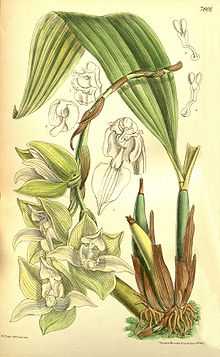Trevoria
| Trevoria | |
|---|---|
 | |
| Trevoria chloris 1900 illustration[1] | |
| Scientific classification | |
| Kingdom: | Plantae |
| (unranked): | Angiosperms |
| (unranked): | Monocots |
| Order: | Asparagales |
| Family: | Orchidaceae |
| Subfamily: | Epidendroideae |
| Tribe: | Maxillarieae |
| Subtribe: | Stanhopeinae |
| Genus: | Trevoria F.Lehm. (1897) |
| Type species | |
| Trevoria chloris F.Lehm. | |
| Synonyms[2] | |
|
Endresiella Schltr. | |
Trevoria is a genus of orchids native to southeastern Central America and northwestern South America. It grows in intermediate temperature and is found from Nicaragua and Costa Rica to Bolivia.[2][3][4][5]
Trevoria was described by FC Lehmann in 1897.[6] A photo of this single plant is also in the new vol 6 of the book Native Colombian Orchids: Volume 6: Supplement: Leucohyle-Zootrophion (1998). The name is in honor of Sir Trevor Lawrence, a former president of The Royal Horticultural Society.
Species
Species recognized as of June 2014:[2]
- Trevoria chloris Lehm. - Colombia
- Trevoria escobariana Garay - Colombia, Ecuador
- Trevoria glumacea Garay - Costa Rica, Nicaragua
- Trevoria lehmannii Rolfe - Colombia, Ecuador
- Trevoria zahlbruckneriana (Schltr.) Garay - Costa Rica, Nicaragua, Ecuador, Bolivia
Culture
The lava stone for culture is watered daily with 200 yS of a urea free mineral NPK fertilizer. Leaves should be dried soon after they get wet to prevent leaf spot fungi. Every 10 days plants should get organic fertilizer over the leaves in a solution of up to 600 yS. Occasionally, fish emulsion or sea weed fertilizer (Bioalgen S90) or an amino acid fertilizer is applied. Other genera that grow well on such stones is the closely related Schlimia and also some terrestrial Polycycnis like P. morganii.
T. chloris flowers are extremely fragrant and do not require pollinators. they are only open for one day.
Concerning sandwich mounts it should be mentioned that Coryanthes were found to grow even better on sandwich mounts without bark, only Styrofoam (make sure by calling the producer its free of Freon or similar toxic substances added to prevent fire in some kinds of styrofoam), some large pieces of broken clay pots and a bit of fiber peat fixed together with a cord made of synthetic material.
References
- ↑ M. S. del. ( = Matilda Smith, 1854-1926), J. N. Fitch lith. ( = John Nugent Fitch, 1840–1927) Description by Joseph Dalton Hooker (1817—1911) - "Curtis's Botanical Magazine"
- ↑ 2.0 2.1 2.2 Kew World Checklist of Selected Plant Families
- ↑ Pridgeon, A.M., Cribb, P.J., Chase, M.C. & Rasmussen, F.N. (2009). Epidendroideae (Part two). Genera Orchidacearum 5: 1-585. Oxford University Press, New York, Oxford.
- ↑ Dressler, R.L. 2003. Orchidaceae. En: Manual de Plantas de Costa Rica. Vol. 3. B.E. Hammel, M.H. Grayum, C. Herrera & N. Zamora (eds.). Monographs in systematic botany from the Missouri Botanical Garden 93: 1–595.
- ↑ Stevens, W. D., C. Ulloa Ulloa, A. Pool & O. M. Montiel. 2001. Flora de Nicaragua. Monographs in systematic botany from the Missouri Botanical Garden 85: i–xlii,.
- ↑ Lehmann, Friedrich Carl. 1897. Gardeners' Chronicle: a weekly illustrated journal of horticulture and allied subjects. ser. 3, 21: 345–346
- Juergen Boehm Orchids